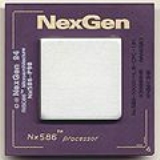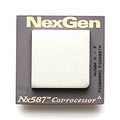
NexGen
Encyclopedia
NexGen was a private semiconductor
company that designed x86 microprocessor
s until it was purchased by AMD in 1996.
Like competitor Cyrix
, NexGen was a fabless design house that designed its chips but relied on other companies for production. NexGen's chips were produced by IBM
's Microelectronics division.
The company was best-known for the unique implementation of the x86 architecture in its processors. NexGen's CPUs were designed much differently than other processors based on the x86 instruction set at the time: the processor would translate code designed to run on the traditionally CISC
-based x86 architecture to run on the chip's internal RISC architecture. The architecture was used in later AMD chips such as the K6, and to an extent most x86 processors today implement a "hybrid" architecture similar to those used in NexGen's processors.
, ASCII
and Kleiner Perkins. Its first design was targeted at the 80386 generation of processors. But the design was so large and complicated it could only be implemented using eight chips instead of one and by the time it was ready, the industry had moved onto the 80486 generation.
 Its second design, the Nx586 CPU, was introduced in 1994, was the first CPU to attempt to compete directly against Intel's Pentium, with its Nx586-P80 and Nx586-P90 CPUs. Unlike competing chips from AMD and Cyrix, the Nx586 was not pin-compatible with the Pentium or any other Intel chip and required its own custom NxVL-based motherboard and chipset. NexGen offered both a VLB
Its second design, the Nx586 CPU, was introduced in 1994, was the first CPU to attempt to compete directly against Intel's Pentium, with its Nx586-P80 and Nx586-P90 CPUs. Unlike competing chips from AMD and Cyrix, the Nx586 was not pin-compatible with the Pentium or any other Intel chip and required its own custom NxVL-based motherboard and chipset. NexGen offered both a VLB
and a PCI
motherboard for the Nx586 chips.
Like the later Pentium-class CPUs from AMD and Cyrix, clock for clock it was more efficient than the Pentium, so the P80 ran at 75 MHz and the P90 ran at 83.3 MHz. Unfortunately for NexGen, it measured its performance relative to a Pentium using an early chipset; improvements included in Intel's first Triton chipset increased the Pentium's performance relative to the Nx586 and NexGen had difficulty keeping up. Unlike the Pentium, the Nx586 had no built-in math coprocessor
; an optional Nx587 provided this functionality.
In later Nx586's, a x87 math coprocessor
was included on-chip. Using IBM's multichip module (MCM) technology, NexGen combined the 586 and 587 die in a single package. The new device, which used the same pinout as its predecessor, was marketed as the Nx586-PF100 to distinguish it from the FPU-less Nx586-P100.
Compaq
, which had backed the company financially, announced its intention to use the Nx586 and even struck the name "Pentium" from its product literature, demos, and boxes, substituting the "586" moniker, but never used NexGen's chip widely.
When AMD's K5
chip failed to meet performance and sales expectations, AMD purchased NexGen.
Semiconductor
A semiconductor is a material with electrical conductivity due to electron flow intermediate in magnitude between that of a conductor and an insulator. This means a conductivity roughly in the range of 103 to 10−8 siemens per centimeter...
company that designed x86 microprocessor
Microprocessor
A microprocessor incorporates the functions of a computer's central processing unit on a single integrated circuit, or at most a few integrated circuits. It is a multipurpose, programmable device that accepts digital data as input, processes it according to instructions stored in its memory, and...
s until it was purchased by AMD in 1996.
Like competitor Cyrix
Cyrix
Cyrix Corporation was a microprocessor developer that was founded in 1988 in Richardson, Texas as a specialist supplier of high-performance math coprocessors for 286 and 386 microprocessors. The company was founded by former Texas Instruments staff members and had a long but troubled relationship...
, NexGen was a fabless design house that designed its chips but relied on other companies for production. NexGen's chips were produced by IBM
IBM
International Business Machines Corporation or IBM is an American multinational technology and consulting corporation headquartered in Armonk, New York, United States. IBM manufactures and sells computer hardware and software, and it offers infrastructure, hosting and consulting services in areas...
's Microelectronics division.
The company was best-known for the unique implementation of the x86 architecture in its processors. NexGen's CPUs were designed much differently than other processors based on the x86 instruction set at the time: the processor would translate code designed to run on the traditionally CISC
CISC
CISC may refer to:*Caribbean Island Swimming Championships*Centre for Innovation and Structural Change*Chongqing Iron and Steel Company* Clean intermittent self-catheterisation, a form of urinary catheterization*Complex instruction set computing...
-based x86 architecture to run on the chip's internal RISC architecture. The architecture was used in later AMD chips such as the K6, and to an extent most x86 processors today implement a "hybrid" architecture similar to those used in NexGen's processors.
History
The company was founded in 1986 by Thampy Thomas, being funded by CompaqCompaq
Compaq Computer Corporation is a personal computer company founded in 1982. Once the largest supplier of personal computing systems in the world, Compaq existed as an independent corporation until 2002, when it was acquired for US$25 billion by Hewlett-Packard....
, ASCII
ASCII (company)
was a publishing company based in Tokyo, Japan. It became a subsidiary of Kadokawa Group Holdings in 2004, and merged with another Kadokawa subsidiary MediaWorks on April 1, 2008, and became ASCII Media Works. The company published Monthly ASCII as the main publication...
and Kleiner Perkins. Its first design was targeted at the 80386 generation of processors. But the design was so large and complicated it could only be implemented using eight chips instead of one and by the time it was ready, the industry had moved onto the 80486 generation.

VESA Local Bus
The VESA Local Bus was mostly used in personal computers. VESA Local Bus worked alongside the ISA bus; it acted as a high-speed conduit for memory-mapped I/O and DMA, while the ISA bus handled interrupts and port-mapped I/O.-Historical overview:In the early 1990s, the I/O bandwidth of...
and a PCI
Peripheral Component Interconnect
Conventional PCI is a computer bus for attaching hardware devices in a computer...
motherboard for the Nx586 chips.
Like the later Pentium-class CPUs from AMD and Cyrix, clock for clock it was more efficient than the Pentium, so the P80 ran at 75 MHz and the P90 ran at 83.3 MHz. Unfortunately for NexGen, it measured its performance relative to a Pentium using an early chipset; improvements included in Intel's first Triton chipset increased the Pentium's performance relative to the Nx586 and NexGen had difficulty keeping up. Unlike the Pentium, the Nx586 had no built-in math coprocessor
Coprocessor
A coprocessor is a computer processor used to supplement the functions of the primary processor . Operations performed by the coprocessor may be floating point arithmetic, graphics, signal processing, string processing, or encryption. By offloading processor-intensive tasks from the main processor,...
; an optional Nx587 provided this functionality.
In later Nx586's, a x87 math coprocessor
X87
x87 is a floating point-related subset of the x86 architecture instruction set. It originated as an extension of the 8086 instruction set in the form of optional floating point coprocessors that worked in tandem with corresponding x86 CPUs. These microchips had names ending in "87"...
was included on-chip. Using IBM's multichip module (MCM) technology, NexGen combined the 586 and 587 die in a single package. The new device, which used the same pinout as its predecessor, was marketed as the Nx586-PF100 to distinguish it from the FPU-less Nx586-P100.
Compaq
Compaq
Compaq Computer Corporation is a personal computer company founded in 1982. Once the largest supplier of personal computing systems in the world, Compaq existed as an independent corporation until 2002, when it was acquired for US$25 billion by Hewlett-Packard....
, which had backed the company financially, announced its intention to use the Nx586 and even struck the name "Pentium" from its product literature, demos, and boxes, substituting the "586" moniker, but never used NexGen's chip widely.
When AMD's K5
AMD K5
The K5 was AMD's first x86 processor to be developed entirely in-house. Introduced in March 1996, its primary competition was Intel's Pentium microprocessor. The K5 was an ambitious design, closer to a Pentium Pro than a Pentium regarding technical solutions and internal architecture...
chip failed to meet performance and sales expectations, AMD purchased NexGen.

